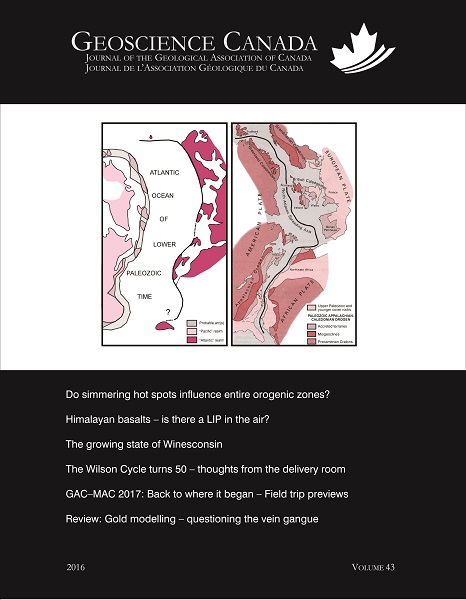Published 2016-12-15
How to Cite
Abstract
The Early Permian (290 Ma) Panjal Traps are the largest contiguous outcropping of volcanic rocks associated with the Himalayan Magmatic Province (HMP). The eruptions of HMP-related lava were contemporaneous with the initial break-up of Pangea. The Panjal Traps are primarily basalt but volumetrically minor intermediate and felsic volcanic rocks also occur. The basaltic rocks range in composition from continental tholeiite to ocean-floor basalt and nearly all have experienced, to varying extent, crustal contamination. Uncontaminated basaltic rocks have Sr–Nd isotopes similar to a chondritic source (ISr = 0.7043 to 0.7073; eNd(t) = 0 ± 1), whereas the remaining basaltic rocks have a wide range of Nd (eNd(t) = –6.1 to +4.3) and Sr (ISr = 0.7051 to 0.7185) isotopic values. The calculated primary melt compositions of basalt are picritic and their mantle potential temperatures (TP ≤ 1450°C) are similar to ambient mantle rather than anomalously hot mantle. The silicic volcanic rocks were likely derived by partial melting of the crust whereas the andesitic rocks were derived by mixing between crustal and mantle melts. The Traps erupted within a continental rift setting that developed into a shallow sea. Sustained rifting created a nascent ocean basin that led to sea-floor spreading and the rifting of microcontinents from Gondwana to form the ribbon-like continent Cimmeria and the Neotethys Ocean.
RÉSUMÉ
Les Panjal Traps du début Permien (290 Ma) constituent le plus grand affleurement contigu de roches volcaniques associées à la province magmatique de himalayienne (HMP). Les éruptions de lave de type HMP étaient contemporaines de la rupture initiale de la Pangée. Les Panjal Traps sont essentiellement des basaltes, mais on y trouve aussi des roches volcaniques intermédiaires et felsiques en quantités mineures. La composition de ces roches basaltiques varie de tholéiite continentale à basalte de plancher océanique, et presque toutes ont subi, à des degrés divers, une contamination de matériaux crustaux. Les roches basaltiques non contaminées ont des contenus isotopiques Sr–Nd similaires à une source chondritique (Isr = 0,7043 à 0,7073; eNd (t) = 0 ± 1), alors que les roches basaltiques autres montrent une large gamme de valeurs isotopiques en Nd (eNd (t) = –6,1 à +4,3) et Sr (Isr = de 0,7051 à 0,7185). Les compositions de fusion primaire calculées des basaltes sont picritiques et leurs températures potentielles mantelliques (TP de ≤ 1450°C) sont similaires à la température ambiante du manteau plutôt que celle d’un manteau anormalement chaud. Les roches volcaniques siliciques dérivent probablement de la fusion partielle de la croûte alors que les roches andésitiques proviennent du mélange entre des matériaux de fusion crustaux et mantelliques. Les Traps ont fait irruption dans un contexte de rift continental qui s’est développé dans une mer peu profonde. Un rifting soutenu a créé un début de bassin océanique lequel conduit à une expansion du fond océanique et au rifting de microcontinents tirés du Gondwana pour former le continent rubané de Cimméria et l'océan Néotéthys.

